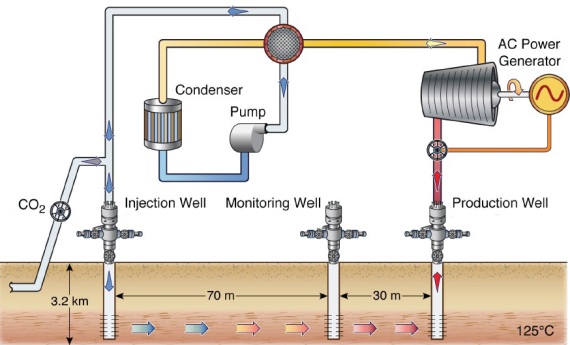Posted 08 August 2011, by Dan Krotz, Lawrence Berkeley National laboratory, newscenter.lbl.gov
About a year from now, two nondescript shipping containers will be installed in a field in Cranfield, Mississippi. They’ll house turbines designed to generate electricity in a way that’s never been done before. If initial tests go well, the technology could lead to a new source of clean, domestic energy and a new way to fight climate change.
A team led by Lawrence Berkeley National Laboratory (Berkeley Lab) scientists hopes to become the first in the world to produce electricity from the Earth’s heat using CO2. They also want to permanently store some of the CO2 underground, where it can’t contribute to climate change.
The group received $5 million from the Department of Energy earlier this summer to design and test the technology.
“This is the first project intended to convert geothermally heated CO2 into useful electricity,” says Barry Freifeld, a mechanical engineer in Berkeley Lab’s Earth Sciences Division who leads the effort.

This looks like a maze, but it's actually a schematic of a way to combine CO2 storage and geothermal energy production. Starting with CO2 on the left, follow the arrows to learn how the proposed pilot test will work.
The idea is to inject CO2three kilometers underground into a sedimentary layer that’s 125 degrees Celsius. CO2 enters a supercritical state under these conditions, meaning it has both liquid and gas properties.
The CO2 will then be pulled to the surface and fed into a turbine that converts heat into electricity. Next,it will loop back underground and through the cycle again. Over time, some of it will be permanently trapped in the sediment. More CO2 will be continuously added to the system to keep the turbines spinning.
The technology could help offset the cost of geologic carbon storage, a promising climate change mitigation strategy that involves capturing CO2 from large stationary sources and pumping it deep underground. This enables the burning of fossil fuels without releasing the greenhouse gas into the atmosphere. But it’s expensive.
“Carbon storage takes a lot of power – large pumps and compressors are needed. We may be able to bring down its costs by generating electricity on the side,” says Freifeld.
It also offers a new way to tap geothermal energy, which is a tough sell in arid regions where every drop of water is spoken for. For more than a decade, scientists at Berkeley Lab and elsewhere have theorized that supercritical CO2 can be used instead of water. Their work has shown that supercritical CO2 is better than water at mining heat from the subsurface. But no one has tried to do it until now.

The pilot test will take place at SECARB's Cranfield site in Mississippi, which has hosted a carbon storage demonstration test for the past two years. In these images, monitoring equipment is being installed in the boreholes.
In the project’s first stage, Ohio-based Echogen Power Systems will design a turbine that can handle “dirty” supercritical CO2laden with hydrocarbons and water accrued during its subsurface journey. Scientists from the University of Texas at Austin will analyze the environmental impacts of the process over its entire life span.
Berkeley Lab scientists will use numerical models to predict how the reservoir will evolve over time as more and more CO2 courses through it. They’ll also determine how much energy can be extracted from the CO2 by coupling reservoir models with Echogen’s turbine models.
In the second stage, the team will build and test the turbine. If that goes well, they’ll operate it during a pilot test at the Southeast Regional Carbon Sequestration Partnership’s Cranfield site, where a Department of Energy-funded CO2injection project has been underway since 2009. The site’s three-kilometer deep reservoir has proven to be an ideal site for carbon sequestration. Much of the infrastructure needed for the test is already in place, including injection and production wells. The CO2 will come from a pipeline operated by Texas-based Denbury Resources.
It’s too early to tell how much electricity the technology can generate in the U.S. That depends on the scale of carbon capture and storage operations and the availability of deep reservoirs that can both heat and store CO2.
The technology also takes advantage of a problem common to conventional geothermal energy. Between five and ten percent of the water injected in these systems is “lost” as it travels through the pore spaces. As this happens, more water must be added, perhaps from municipal sources that have little to spare.
“But we actually want some of the CO2 to become trapped,” says Freifeld. “Our approach relies on this gradual loss as a way to store a power plant’s CO2 underground rather than emitting it into the atmosphere. Our planned demonstration is the first attempt at proving that we can simultaneously mitigate greenhouse gas induced climate change and generate clean baseload power using geothermal energy.”
###
Lawrence Berkeley National Laboratory addresses the world’s most urgent scientific challenges by advancing sustainable energy, protecting human health, creating new materials, and revealing the origin and fate of the universe. Founded in 1931, Berkeley Lab’s scientific expertise has been recognized with 12 Nobel prizes. The University of California manages Berkeley Lab for the U.S. Department of Energy’s Office of Science. For more, visit www.lbl.gov.
Additional information:
- The team members include scientists and engineers from Berkeley Lab; the University of Texas at Austin; Echogen Power Systems, Inc.; and Australia’s Commonwealth Scientific Industrial Research Organization.
- Department of Energy news release announcing the Berkeley Lab-led project and several other geothermal projects
http://newscenter.lbl.gov/feature-stories/2011/08/08/geothermal-co2/




